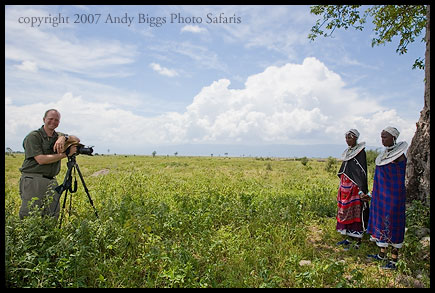A photo shoot with the Maasai
 Saturday, February 17, 2007 at 09:13AM
Saturday, February 17, 2007 at 09:13AM A friend came and picked me up, we grabbed some picnic food at a local market (and some Kilimanjaro beers, of course), and headed out. I had my friend Al Vinjamur with me, as well. The goal for me was twofold: to enjoy a relaxing day of mixing in with some of the Maasai, and to capture some nice portraits on a borrowed Hasselblad H2 / CFH39 medium format camera setup. The CFH39 digital back captures near full-frame 6x4.5cm digital images, and has a native file dimension of roughly 5400x7200 pixels. That is 39 megapixels, which is stunning if used correctly.
We arrived in the late morning, and were greeted by the head of the village. He had already arranged for 12 young Maasai women to pose for us, and they were sitting underneath a very large baobab tree waiting for us. We also asked for some morani warriors to be available once we were finished photographing the ladies.
I chose not to introduce artifical light into this session, as I was not familiar with the flash system on the Hasselblad platform. On my next return to the area in June, I will likely be bringing a single Profoto strobe system with me. Their new Acute 600B system is very very enticing, as the battery pack weighs less than 11 pounds. My other alternative will be to bring a Quantum Qflash setup with me, which is much smaller and lighter, but only packs about 320watts. Not quite enough for what I want to accomplish in the midday sun.
For my shoot, I setup three different scenarios. For the first scenario, I brought the Maasai women out into the harsh light, but had an assistant hold a 42" Photoflex diffuser over each of their heads and shoulders. This allowed me to capture them without them having to squint, and it also accomplished the goal of softening the light. I also had a 42" Photoflex 5-in-1 reflector with me, but we could never arrive at a fill light that didn't overpower their eyes, causing squinting. So we bagged the 5-in-1 and went about the shoot.

For the second scenario, I just positioned my subjects underneath a large baobab tree. The dappled light seemed to work well, so I just went with that.
 Safaris
Safaris 


Reader Comments (2)